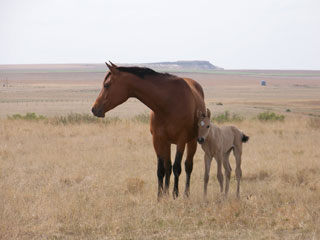
 |
| Castle Rock is pictured in the background |
The 1803 Louisiana Purchase, orchestrated by President Thomas Jefferson, merged into the United States, the great expanse we now know as Western Kansas. In 1865, entrepreneurs seized an opportunity for trade with Denver City – on the western edge of what was then Kansas Territory – and established the Butterfield Overland Despatch (BOD) Trail. The BOD followed the Smoky Hill River to the Hackberry Creek (in modern-day Trego County), where Downer’s Station was built, and where the trail took a short deviation along the creek; an Indian raid later destroyed the station. Although the part of our ranch (affectionately called Dinosaur because of its many fossils) which includes the Smoky Hill River was by passed by the route’s deviation, Castle Rock – a prominent landmark on the trail – can be seen in the background of some of our photos. And though the BOD didn’t cross our land, the WaKeeney-Dighton Stagecoach did – and (according to history) so did the famous George Armstrong Custer. Stagecoach ruts remain visible, and we have ridden horseback on the river bank where then-Lieutenant Custer and his cavalry troops trod.
In 1877, business partners Albert Warren and James Keeney formed the Warren, Keeney & Co. and set about designing “The Queen City of the High Plains” – WaKeeney. The town was planned in a Chicago office, including the 80-foot wide streets for which we are grateful in this day of the automobile. Known today as “The Christmas City of the High Plains,” a 35-foot Christmas tree is decorated annually in the intersection of Main Street and Russell Avenue. Trego County – for which WaKeeney is the county seat – was organized in June of 1879 and named for Civil War Captain Edgar Poe Trego, of the 8th Kansas Division, who died in the 1863 Battle of Chickamauga.
The Kansas Pacific Railway reached WaKeeney in the 1870s. About a mile west of town, the crew building track came under Indian attack. History records show that some of the crew fled northward and sought refuge under a cliff. Although the exact location is now unknown, we pasture the area, and our imagination is fueled as we ride by the cliffs and contemplate that these outcroppings – a serene scene for grazing cattle and horses and even Christmas card photos – were once defensive positions for men engaged in the fight of their lives.
Area State historical sites include Old Fort Hays, Fort Wallace, and Cottonwood Ranch; National attractions are Ft. Larned and Nicodemus. Castle Rock and the Sternberg Museum (home to some of the aforementioned fossils) are also nearby. A little further northeast is the cabin where Dr. Brewster M. Higley in the early 1870s penned the words to a poem he titled “My Western Home” – which was set to music in 1947, and became the Kansas State Song we know as “Home on the Range.”
Oh, my – for those who travel this area and think it is just boring “flyover” country – what a rich history we have! This is why we are proud to call this Our Home on the Range of the Great American Plains!